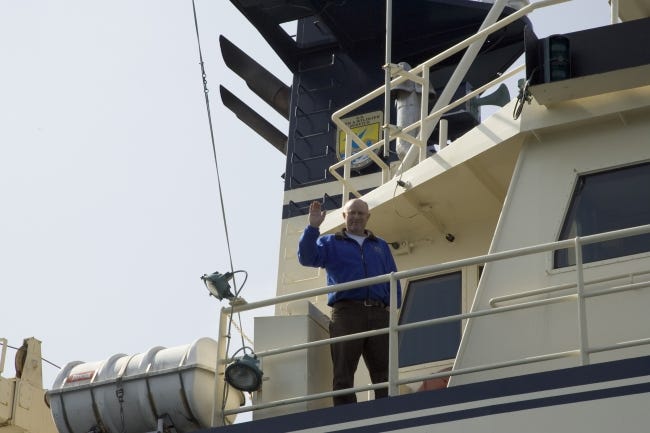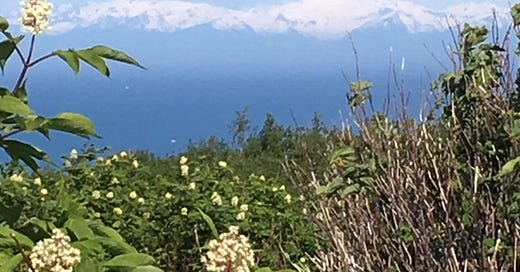I first started writing this post on Earth Day; it seemed only fitting that I explore the backstory. The first Earth Day took place on April 22, 1970, and was the brainchild of Gaylord Nelson, an environmentally minded Senator from Wisconsin. Nelson, unable to interest his political peers in providing environmental protections, turned to the public for support. After a devastating oil spill off the coast of Santa Barbara dumped 80,000 to 100,000 barrels of crude oil in the Santa Barbara Channel in 1969, Senator Nelson capitalized on growing national concern. He hoped that public outcry would ideally, and ultimately, convince his peers in Congress that environmental protections and regulations needed to be put in place. He proposed a day for Americans to speak out about environmental crises they’d experienced. He first floated his idea for a grassroots movement to a fledgling group of environmentalists in Seattle on September 9th. Six days later, he spoke at a United Auto Workers meeting in Atlantic City. Within weeks, the Earth Day idea became the national grassroots movement Nelson had hoped for, as both the United and Associated Presses began spreading the word. Other momentum had been gaining traction through voices like Rachel Carson, in her book, Silent Spring. People, including president Kennedy, were beginning to listen.
The, then, largest oil spill in the U.S. was not the only environmental disaster rocking the public’s conscience. Plants and factories all along the rivers of our country were dumping waste, sometimes toxic, into the water; the Potomac stunk from hundreds of millions of gallons of waste; the Cuyahoga River burst into flames; Lake Erie’s oxygen content was so negligible that there was little life present in the center; smog was killing people; and levels of auto exhaust were so high in places it was deemed to potentially cause birth defects. Teflon began coating our cookware; it wasn’t until decades later that we learned the devastating consequences of PFAS.
In November of 1969, riding on the thrust of national discontent, Nelson and his staff announced that a “National Teach-In on the Crisis of the Environment” event would be held on college campuses April 22nd, 1970. The date was chosen to appeal to college students - falling between spring break and final exams - who, at the time (think Viet Nam era) were more likely to be politically active and vocal. Twenty million Americans participated in that first Earth Day back in 1970, 10% of the U.S. population at that time. Earth Day has been nationally recognized on April 22nd for 55 years and globally for 35.
The event and public participation gave rise to the Environmental movement and the eventual formation of the Environmental Protection Agency orchestrated by Richard Nixon. I include an excerpt of his State of the Union Address in 1970 because I find its message poignant and relevant in today’s current political climate:
The great question of the seventies is, shall we surrender to our surroundings, or shall we make our peace with nature and begin to make reparations for the damage we have done to our air, to our land, and to our water?
Restoring nature to its natural state is a cause beyond party and beyond factions. It has become a common cause of all the people of this country. It is a cause of particular concern to young Americans, because they more than we will reap the grim consequences of our failure to act on programs which are needed now if we are to prevent disaster later.
Clean air, clean water, open spaces-these should once again be the birthright of every American. If we act now, they can be.
We still think of air as free. But clean air is not free, and neither is clean water. The price tag on pollution control is high. Through our years of past carelessness we incurred a debt to nature, and now that debt is being called.
“Through our years of past carelessness, we incurred a debt to nature, and now that debt is being called.” That’s a powerful and moving statement from a somewhat surprising source. Fast forward 55 years, President Trump orders the agencies that regulate energy and environment to ‘sunset’ a wide array of environmental protections in an executive order issued earlier this month. The EPA and sister agencies like the Energy Department, the Nuclear Regulatory Commission, the Bureau of Safety and Environment, as well as the Fish and Wildlife Service, have been ordered to amend existing regulations so that they expire by October 2026. The dismantling of the agencies designed to offer protections to Mother Earth, her lands and her people is blueprinted in Project 2025.
Last week, Secretary of Interior, Doug Burgum, officially handed over comprehensive authority to a member of DOGE. Tyler Hassan, an ex-oil executive, was given full reign as the assistant secretary of policy, management and budget in the Department of the Interior. He has the authority to take “all necessary actions” to carry out “consolidation, unification and optimization” at the department and its bureaus, states the order from Burgum.
“If Doug Burgum doesn’t want this job, he should quit now,” says Jennifer Rokala, executive director the Center for Western Priorities. The Center for Western Priorities describes itself as a nonpartisan land conservation policy organization. “Instead it looks like Burgum plans to sit by the fire eating warm cookies while Elon Musk’s lackeys dismantle our national parks and public lands.” She elaborates, “DOGE’s unelected bureaucrats in Washington have no idea how to staff a park, a wildlife refuge, or a campground. They have no idea how to manage a forest or prepare for fires in the wildland-urban interface. But Doug Burgum just gave DOGE free rein over all of that,” she said.
I think of our friend, Kevin Bell. He worked tirelessly as the captain of the Fish and Wildlife Service marine vessel, Tiglax. Kevin loved working for Fish and Wildlife; he was one of our closest friends, at the time, who was associated with the government agency. And, oh! He was so proud of his vessel, his crew and their mission to transport scientists, researchers, and supplies in order to manage the Alaska Maritime National Refuge and to collect information on related marine resources. He was passionate about the marine life on the Aleutian Islands and elsewhere. If Kevin were still here, I can’t help but imagine the displeasure he’d voice. M, forgive me for this unintended excerpt. Thoughts of Kevin literally sprang to mind as I was writing this. Now, tears spring to my eyes as I think of how all the measures and protections people like Kevin helped implement may be swiped away with a stroke of a pen.

But there is hope; we, the people, still have our voices and can make known our indignation and unwillingness to roll back measures put in place to protect us and our good earth. The courts, so far, have offered a bulwark for now. I read there are currently 208 court cases pending against the administration. Recently, a federal judge has temporarily blocked the EPA from canceling $14 billion in climate grants; many conservation organizations are taking legal action as DOGE affects national parks. PBS aired an Earth Day interview with Bill McKibben, a well known environmentalist, of 350.org and Third Act. McKibben has been sounding the alarm about climate change and global warming for many years now; we would do well to heed his warnings. Take a listen: How the Trump Administration is Dismantling Climate Protections.
What are small steps you and I can take every day to protect our home? Tony Brady offers suggestions in his meditation Make Love to the Earth Today, found on Insight Timer. His talk is delivered in his gentle Irish brogue; something about his voice provides me with feelings of warmth, trust and being safe. Take a listen for yourself; it may inspire you, too. Listening to him, I pondered the small ways I’m being thoughtful - or not - about living on this planet. I often greet my day outside under a big old maple tree out back; I allow the energy of the tree to sustain me for the day ahead. And I give thanks to all that nature provides. I promise to protect my tree and all of nature’s gifts to the best of my ability. I donate to environmental organizations; I’m conscientious about my use of plastics using reusable grocery bags often; I use laundry sheets to eliminate the waste of the plastic container. These are small actions, but if we all do small things together, they could add up to a big thing!
On a lighter note, a years long personal mystery was solved this week. A prime example of how tangled and intertwined our memories become over the years, I finally sought the answer to why the actor Frank Converse and the song, “Love is Blue” have been linked together in my mind since I was a young girl. I took the time to look up Frank Converse, whose name popped into my head while I was doing yoga last week. I stopped mid-pose to jot his name down on a piece of paper that’s now been sitting beside my computer for several days. His name has come in and out of my conscious for decades; thoughts of his name are always accompanied by the melody of Paul Mauriat’s classic, "Love is Blue."
Here’s the interesting part; I’m remembering Frank Converse from the TV series, Coronet Blue, that first aired in 1967. I was 12 years old and fell head over heels in love, I mean seriously in love, with Frank Converse as I devotedly watched him in the role of ‘Gigot’, a man pulled from the river with no name and no history. Incidentally, one of my all time favorite songs (and one I proceeded to learn how to play on the piano), “Love is Blue” made it’s debut in 1967, topping Billboards Hot 100. My mind has kept the two unrelated memories interwoven for over 50 years. Today, I, at long last, set the record straight. Knowing what I know now, it makes absolute sense and I’m glad I took the time to parse this mystery out. The mystery solved makes me smile and that feels good. Reasons to smile must be a daily priority!
Other reasons to smile…Spring has seemingly come to New England. Admittedly, one of my great pleasures is watching nature wake up from its winter’s long sleep. I love bearing witness to new growth as it pokes through the ground, to the hint of yellow/green slowly unfurl into lush new leaves on trees and bushes, to the tight bud’s release into beautiful spring blossoms. Perennials are beginning to reveal themselves after dormancy and it’s almost time to plant my peas! There is something most hopeful and faith inspiring in watching Mother Nature do Spring.
We also mourn the death of Pope Francis this week. I marvel at the timing of his death, the day after Easter, as we revel in the season of renewal. May his spirit of love, compassion, and kindness continue to bloom in all of us. Though not Catholic, I feel a depth of gratitude to Pope Francis and all he conveyed as ‘Pope of the People’. May his goodness be carried forward by his successor and all those who lead.
Remain curious. Be Kind - to others and to yourselves. Be Well. As Always With Love.
Sources:
https://time.com/4696104/environmental-protection-agency-1970-history/
https://www.realsimple.com/holidays-entertaining/earth-day-facts
https://nelsonearthday.net/gaylord-nelson-earth-day-origins/
https://thehill.com/policy/energy-environment/5259589-interior-secretary-doug-burgum/
https://slate.com/technology/2025/04/doug-burgum-interior-secretary-musk-doge-national-parks.html
https://www.pbs.org/newshour/show/how-the-trump-administration-is-dismantling-climate-protections
https://insighttimer.com/tonybrady/guided-meditations/make-love-to-the-earth-today



